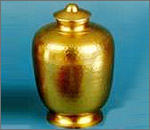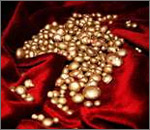By far the preferred copper alloy in antiquity was bronze. Bronze is a combination of copper and tin, usually roughly nine parts copper to one part tin. In some cases additional elements w

ere added as well. As noted, copper itself is quite a soft metal, and only marginally useful for tools, but the introduction of tin much increases its hardness as well as making casting easier.
Increasing the amount of tin in the alloy much above 10% produces greater brittleness, and tools made that way easily break. However alloys with more tin —potin (up to 20% tin) and speculum (more than 30% tin)— were used for early coins in some parts of Europe, where bittleness was not a significant problem.
Copper is found in many places in the world, although not universally. Tin, in contrast, is actually rather rare. Thus the production of bronze depends upon felicitous location or successful trade, and it was always a luxury product in the ancient world, even when "useful" products were made from it. Control of copper and tin mines, and of associated trade routes, therefore became important to the wealth and prestige of many peoples, and, when bronze weapons came into general use, important to their security as well.
Antimonial Bronze:
The introduction of antimony in addition to the tin and copper produces a harder bronze, better able to hold a cutting edge and less likely to be bent in use.
Arsenical Bronze:
Like antimony, arsenic added to the tin and copper (up to as much as 3% of the whole) produces a harder final product. Arsenic fairly routinely occurs as an impurity in early bronze anyway, and small amounts of it were probably not intentional or particularly noticeable in the final product. By the time the proportion of arsenic in bronze reaches two or three percent, however, the effects are quite noticeable and presumably intentional. It is to these products that the term "arsenical bronze" is usually applied.
Lead Bronze
Mixing lead into the copper-tin alloy produces "lead bronze," which may contain as much as 10% lead. The lead in the alloy does not become part of its crystalline structure, increasing the

fluidity of compound when it is in its molten state. This facilitates casting, particularly the casting of finely detailed artistic objects. However lead bronze is softer than normal bronze, and therefore less able to hold a cutting edge, making it less appropriate for many types of tools.
The Bronze Age
The term "Bronze Age" refers to those periods around the world in which bronze was in general use. The specific dates of course vary from region to region, and vary also with the rigiditywith which one defines "general use." The Bronze Age in any given place is considered to have come to an end when the generalization of iron brought on the beginning of the Iron Age, an equally problematic term.


